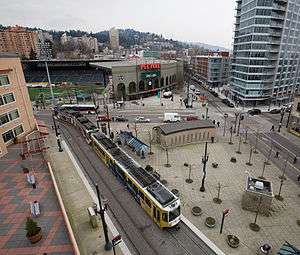Providence Park station
Providence Park is a light rail station on the MAX Blue and Red lines located in the Goose Hollow neighborhood of Portland, Oregon. It is named after the adjacent stadium, Providence Park. The station primarily serves Providence Park and residential areas around West Burnside Street. The station, consisting of separate eastbound and westbound platforms built into city sidewalks between SW 17th and SW 18th Avenues on SW Yamhill and SW Morrison Streets, opened on August 31, 1997.[1]
Providence Park | ||||||||||||||||||||
|---|---|---|---|---|---|---|---|---|---|---|---|---|---|---|---|---|---|---|---|---|
| MAX Light Rail station | ||||||||||||||||||||
 Westbound platform in 2008 | ||||||||||||||||||||
| Location | SW 18th and Morrison (westbound) SW 17th and Yamhill (eastbound) Goose Hollow, Portland OR USA | |||||||||||||||||||
| Coordinates | 45°31′18.5″N 122°41′23″W | |||||||||||||||||||
| Owned by | TriMet | |||||||||||||||||||
| Platforms | Side platforms | |||||||||||||||||||
| Tracks | 3 | |||||||||||||||||||
| Construction | ||||||||||||||||||||
| Bicycle facilities | Lockers | |||||||||||||||||||
| Disabled access | Yes | |||||||||||||||||||
| History | ||||||||||||||||||||
| Opened | August 31, 1997 | |||||||||||||||||||
| Previous names |
| |||||||||||||||||||
| Services | ||||||||||||||||||||
| ||||||||||||||||||||
| ||||||||||||||||||||
Originally named Civic Stadium,[1] it was renamed to PGE Park in 2001, Jeld-Wen Field in 2011, and to its present name in 2014. All of the renamings were the results of changes in the name of the stadium.[2]
Station details
Tracks split just outside the station on SW 18th Ave. into eastbound tracks on SW Yamhill St. and westbound tracks on SW Morrison St. This split results in a transit mall east to SW 1st Ave.
The Morrison platform is at an angle to the street grid and has a regular side platform which fronts a small public plaza. There is also a second platform and storage track used for special events. The Yamhill Street platform takes the entire block from 17th to 18th. A large apartment complex occupies the space between the platforms.
Public art

The station's southern platform (used by eastbound trains), on Yamhill Street, was located directly adjacent to the longtime printing plant of the city's major newspaper, The Oregonian,[3] until the plant's closure in 2015[4] and demolition in 2018.[5] As a reflection of this, TriMet chose "communication" as the theme for the public art at this station – known as Civic Stadium station at the time of its opening, in 1997 – "celebrating the importance of communication to the vitality of our city".[6]
The Yamhill platform features unique seating shaped like punctuation marks.[7] The nearby westbound platform features small bronze pedestals in the shapes of a "stump, capital and soapbox, suggest[ing] podiums for impromptu oratories".[7] A utility building is adorned with stainless-steel panels etched with poems by writer Robert Sullivan on the history of the region and "great moments in Oregon free-speech history", Oregonian architecture critic Randy Gragg wrote in a 1998 review.[7]
Bus line connections
This station is served by the following bus lines:
- 15-Belmont/NW 23rd
- 18-Hillside
- 51-Vista
- 63-Washington Park
The line 20-Burnside/Stark also stops two blocks north of the station on West Burnside Street at NW 19th Avenue (westbound) and NW 18th Avenue (eastbound).
References
- O'Keefe, Mark (September 1, 1997). "New MAX cars smooth the way for wheelchairs". The Oregonian. p. B12.
- Brettman, Alan (March 5, 2014). "City, Timbers do not have to disclose naming rights dollars for publicly owned stadium, city says". The Oregonian. Retrieved March 6, 2014.
- Gragg, Randy (August 31, 1997). "Light rail, lite art". The Sunday Oregonian. p. F1.
- Mesh, Aaron (July 7, 2015). "Shop the Presses: The Oregonian is selling its printing press—and advancing deeper into the web". Willamette Week. Archived from the original on October 13, 2019. Retrieved October 13, 2019.
- Njus, Elliot (October 5, 2018). "Seattle developer to start construction on 'Press Blocks' office building". The Oregonian/OregonLive. Retrieved October 13, 2019.
- "Transit Station: Civic Stadium". TriMet. August 27, 1997. Archived from the original on January 22, 1998. Retrieved October 15, 2019.
- Gragg, Randy (September 9, 1998). "A platform to reveal the art of the journey". The Oregonian. p. C12.
External links

- Station information (with southbound/westbound ID number) from TriMet
- Station information (with northbound/eastbound ID number) from TriMet
- MAX Light Rail Stations – more general TriMet page